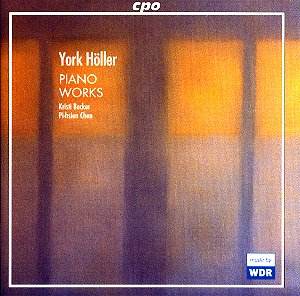Here is a major release.
Acting as a reminder of the stature
of the music of York Höller, this
is a remarkable product.
Höller was born
in Leverkusen in 1944. Having attended
Boulez’s analysis courses at Darmstadt
in 1965 and undergoing a spell as répétiteur
at the Bonn Opera (under Hans Zender),
Höller worked at the Cologne WDR
Electronic Music Studio at the invitation
of Karlheinz Stockhausen. In 1978 he
received his first invitation to IRCAM.
His opera, Der Meister und Margarita
(after Bulgakov: to be reviewed on this
site) was premièred at the Paris
Opéra in 1989 after a 5-year
gestation. From 1990-2000, Höller
was Artistic Director of the Cologne
WDR Studio; in 1995, he succeeded Hans
Werner Henze as Professor of Composition
at the Cologne Academy. One of his most
recent compositions, Der Ewige Tag
(2001) has been recorded
on the Avie label.
Kirsti Becker is pianist
of Ensemble Köln and as such is
modern music-saturated. Challenging
music such as found on this disc is
her bread and butter, and she sounds
totally at home here. Taiwanese pianist
Pi-hsien Chen premiered Höller’s
Pensées (Piano Concerto
No. 2 with live electronic music) in
1993. Competition prize winner several
times over, she has collaborated with
Boulez, Stockhausen and Kurtag; she
has recorded Boulez’s Notations and
Structures II for CBS, and Schoenberg’s
complete piano music (hat(now)ART).
Chien has been professor of piano at
the Cologne Academy since 1983.
CPO has therefore chosen
two of the most apt players imaginable
for this disc. The first work (and the
earliest: the pieces are presented chronologically)
is the Five Pieces of 1964. Höller
sees this as his ‘Op. 1’ (he destroyed
many earlier works on the grounds they
were not ‘progressive’ enough), although
he states that he was, ‘still too strongly
oriented toward Hindemith, Bartók
and Stravinsky, toward composers who
from the perspective of the so-called
Second Viennese School were not regarded
as ‘progressive’ enough’. The Five
Pieces is a result of Höller’s
immersion in the music of Schoenberg,
Berg and Webern, a fascination that
began in 1963. All five pieces derive
from one twelve-note row. There is an
intense concentration to the second
piece, ‘Sehr zart, poco rubato’ that
is entirely indicative of this composer’s
seriousness of intent. The ‘Pesante’
fourth piece organically grows in front
of one’s very ears; the finale is very
much the ‘Toccata’ of its title. Rhythmically
vital à la Bartók, Becker’s
playing exudes confidence and belief.
Diaphonie (1965,
for two pianos) was written on the 20th
anniversary of Bartók’s death,
although Höller candidly admits
that, ‘in its style and compositional
technique this work no longer has anything
to do with Bartók’. Instead,
the serialism Höller met in Darmstadt
is manifest (although this is not integral
serialism), the Bartók link coming
in the shape of a filling-out of the
introductory motif of the earlier composer’s
Sonata for Two Pianos and Percussion
to form a twelve-note row. Diaphonie
speaks with Boulezian asceticism
and a positively Webernian use of silence
as an integral part of the ongoing musical
argument. Bartók’s influence
can perhaps be heard in the percussive
use of the piano (the pianists here
reveal tremendous finger strength).
Aurally, the delicate tapestries of
sound towards the close of the work
(around 9’30) are most appealing, circling
around fanfare-like repeated notes.
The two piano sonatas
are separated by 18 years. The first
carries the subtitle, ‘Sonate informelle’,
derived from Adorno’s essay, ‘Vers une
musique informelle’, an essay that embraced
free atonality with open arms. So, indeed,
Höller’s work is freely atonal.
From the arresting cluster of the very
beginning, tremendous energy is in evidence.
Yet there is delicacy here, too. The
second movement is a ‘meditation on
the core interval of the major seventh’
(listen also for the beautiful right-hand
filigree at around 2’50 in); the fast
finale is not only fleet of finger but
also fleeting of impressions. As soon
gets a hold on the shifting expressive
world, it has moved to another space.
Becker is a stalwart interpreter.
However, the Second
Sonata is an even finer piece, and correspondingly
Chen seems to play even better. This
work is in homage of Liszt (Höller’s
own notes explain the derivations of
pitch material from ‘Feux follets’,
and there is also a reference to the
late piano piece, Unstern). There
is a gritty determination to both the
writing and the playing, although Chen
finds dancing elements along the way,
too. This is a performance of great
conviction and is without doubt the
highlight of the disc.
Finally, Partita
(1996), a homage to Bernd Alois Zimmermann
but inspired by the spirits of J. S.
Bach and Debussy (‘Général
Lavine’ is quoted in the final movement),
is a tour-de-force. Each of its six
movements has an archaic title: Preludio,
Fuga, Fantasia I, Conductus, Fantasia
II and Gigue. The Fuga is exciting,
but the most visceral movement is the
almost orchestral fourth movement (Conductus),
in which ostinati underpin an ongoing
aggregation of textures. An infectious
Gigue, not without a sense of humour,
rounds the work off.
This is eminently rewarding
music. This disc should be investigated
without delay.
Colin Clarke
